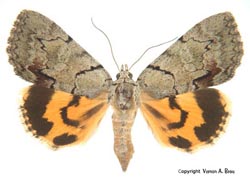
| **8878 Catocala alabamae;
Alabama Underwing; 30-40mm;
Uniform greenish-grey fw may have thin but dark (contrasting) lines or they may be nearly absent
(titania); alabamae often with dash in median/anal angle area, missing or nearly absent in titania.
Brown shading between pm line/subterminal line. Hw inner black band thin, outer
band thick, truncated before being followed by large black dot. Early flight season.
|
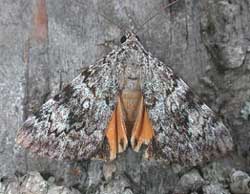
| **8878 Catocala amica;
Girlfriend; wingspan: 35-40mm
The black postmedian band is absent from the dorsal (upper)
surface of the hindwing, but it is present on the ventral surface.
Moths come in to lights and to bait.
Catocala amica lineella is now (2010) elevated to full species status as Catocala lineella.
Maurice Bottos image.
|
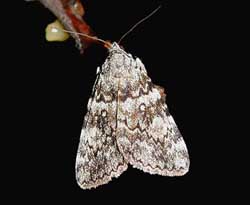
| ** 8878.1 lineella;
Little Lined Underwing; wingspan: 35-40mm.
This species is without hw marginal black band. Fw subreniform spot is pale and boldy
outlined with black. There is similar light brownish-gray patch in
upper half of median area near pm line, and just between
subreniform spot and am line there is similarly
coloured light patch paralleling am lne.
The reniform spot is dark, less distinct and in a generally darker
area.
|
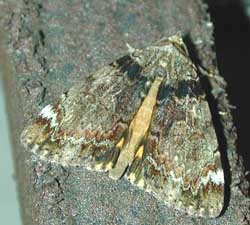
| ** 8874 Catocala minuta TM;
Little Underwing, 35-45mm;
Fw grey-brown, greatly widened, white, st line
(near costa only).
Hw outer black band unbroken, inner band
in complete loop, brown scaling along
im.
"eureka" Schwarz: blackish area between am,pm lines;
"hiseri" Cassino: dull grey fw, very faint markings;
"mellitula" Hulst: blackish patch in basal area from costa to
im;
"obliterata" Schwarz: melanic form, almost completely
black fw;
"parvula" W. H. Edwards: broad dark patch along fw i. m..
|
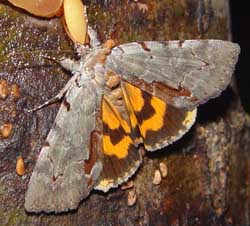
| ** 8864 Catocala grynea ; Woody Underwing, wingspan: 40-50mm
The forewing is a dull greenish grey with orangey-brown shading along
the inner margin. The antemedial, median and postmedial lines are
quite faint.
Praeclara is somewhat similar but has a break in the brown shading
between the am and pm lines. Praeclara also has a paler orange
hindwing color.
Tim Dyson image. |
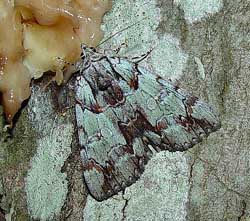
| ** 8865
praeclara; Praeclara Underwing,
wingspan: 40-50mm.
Fw pale greenish-grey with considerable contrasting
brown shading beyond post medial line.
There is a black basal dash very close to the inner margin and
another dash, higher up in the median area.
Note the contrasting shapes of the reniform and subreniform spots.
Upper of two larger pml teeth is longer, wider than lower tooth.
Note double, white filled amls.
Lighter, subcircular patch, outlined in black, brown on lower thorax.
|
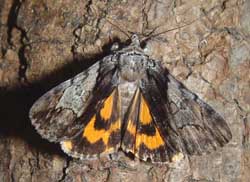
| ** 8858
Catocala crataegi unconfirmed;
Hawthorn Underwing, wingspan: 40-50mm
Determination is based on dark (black) shading in forewing basal
area continuing along inner margin to anal angle and brown shading
beyond postmedial line. Definite greenish cast to
median area.
Lower wing has outer black band, broken near anal angle,
distinguishing crataegi from blandula.
|
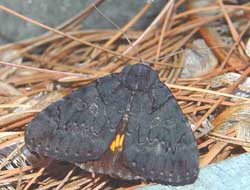
| ** 8775
antinympha;
Sweetfern Underwing, wingspan 45-55mm.
Very dark grey, almost black, forewing ground colour
distinguishes antinympha. Some brown shading in
subreniform spot and also just outside postmedial line.
The hindwing is amber to pale orange.
There is also the form multoconspicua Reiff, 1919 with a pale,
almost white subreniform spot.
|
Midsized Orange-Salmon-Red-Scarlet Underwings: Wingspans: 50-72mm
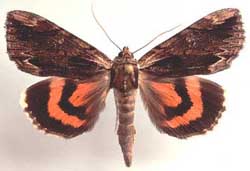
| ** 8857 Catocala ultronia;
Ultronia Underwing, wingspan: 50-63mm.
Fws typically gray-brown, with a distinct and very
dark inner margin and characteristic light brown patch, underscored
by very dark arc, near wingtip.
Underwings can be yellow to orange to salmon.
|
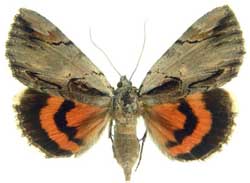
| ** 8857 Catocala ultronia form lucinda;
Ultronia Underwing, wingspan: 50-63mm.
In form lucinda most of the forewing
is bright grey. On all forms there is
extensive orange-salmon colouration on hw ventral surface,
and there is a dark discal lunule.
|
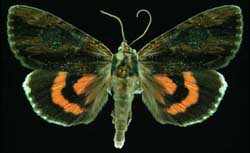
| Catocala ultronia,
form nigrescens, the Ultronia Underwing, wingspan: 50-63mm.
In the melanic form nigrescens, the dorsal forewing is very dark.
Even darker subapical arc, basal dash and dash near anal angle are still visible.
Dark basal hairs on hindwing.
Harold J. Vermes slide, used with permission from his son.
|
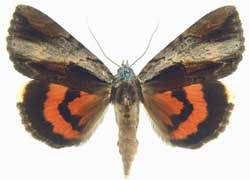
|
In form celia there is a wide, light grey band separating a dark region along inner margin and
a dark patch near the apex.
The ventral surface of forewings of all forms has a generous suffusion
of orange-salmon scales in the lower half of the median area.
|
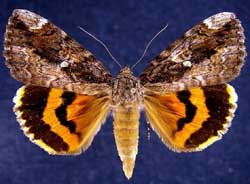
| ** 8770
Catocala innubens;
Betrothed; 55-72mm.
Forewing is mottled with white, grey and brown, and
subrenifrom spot tends to be lighter in colour, although it is
sometimes obscured by an indistinct blackish bar which runs from
middle of basal/thorax connection to just below much lighter
apex at outer margin.
Jim Vargo image. |
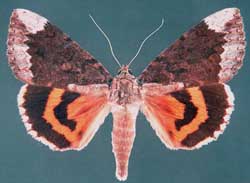
| ** 8770
Catocala innubens form scintillans;
Betrothed; 55-72mm.
In form scintillans most of the basal area (all but lower third) and all of the median area of the forewing is dark reddish brown.
The area outside the pm line is grey.
Vernon A Brou image. |
Solid Black Underwings: Smallest to Largest, Similar Species Paired
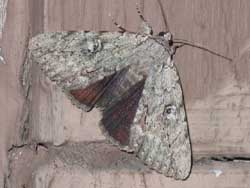
| ** 8781
judith,
Judith's Underwing, (wingspan: 45-55mm), yes,
small "black" underwing. FW uniform
light grey with thin, only slightly darkened am, median
and pml lines. No darkened dashes (slight anal dash)
or transverse lines. Reniform area slightly darkened while
area just before subterminal line is bit lighter. Note absence of
hw white fringe. Joe Garris photo. unconfirmed
|
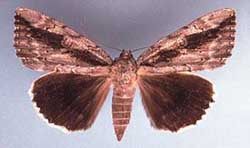
| ** 8782 Catocala flebilis, yes;
Mournful, wingspan: 54-65mm.
Diffuse black band runs from basal area to
outer margin just below apex, interrupted by pale grey
subreniform spot. Reniform spot is filled with brown; there is
additional brown outside postmedial line. No anal dash
as there is in angusi. The hindwings have white fringe. J. K. Adams
image. |
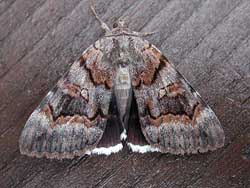
| ** 8773
Catocala epione , yes;
Epione Underwing, wingspan: 55-65mm
The pm line is squared and has a brown band and then a light band
just outside the line. The hindwing is black with pure white fringe
with no barring.
John Himmelman image.
|
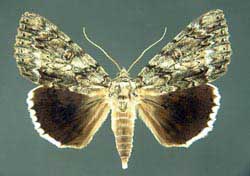
| Catocala ulalume,
Ulalume Underwing, (wingspan: 65mm).
Fw mottled light to dark grey, no strongly contrasting lines, dashes, bars. Aml ends at im in very light coloured
crescent, close to pml. Open subrenifrom spot light coloured, "comma" shaped with triangular, somewhat bulbous head.
Aml: short, thin, slightly humped dark line through midpoint. Hw black, fringe pure white, thin,
pointed checking.
|
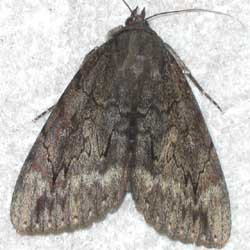
|
Catocala residua;
Residua Underwing, (wingspan: 60-73mm),
distinguished from Catocala obscura by grey hw
fringe of residua.
Catocala obscura has white to off-white fringe and tends to be
less common in northern portions of its range. Fw
subterminal line/area of Catocala residua tends to be pale as
is its open, elongated subreniform spot.
Like C. obscura it is otherwise devoid of significant markings
except for hint of dark bar running from basal area
through reniform spot to o. m. just below apex.
|
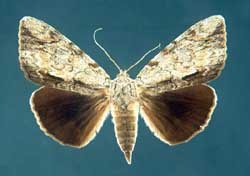
| ** 8791
Catocala insolabilis;
Inconsolable, wingspan: 65-75mm;
Fw light grey with blackish shading along inner
margin. Antemedial and postmedial lines are thin.
Hw fringe very narrow and grey, becoming whiter toward
apex.
Ventral surface clearly distinguishes insolabis, being almost
completely black except for some white in basal area.
Vernon A. Brou image.
|
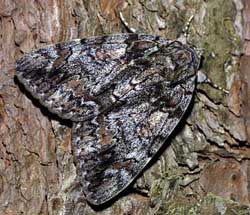
| ** 8794
Catocala lacrymosa;
Tearful Underwing, 60-82mm.
The forewing is highly variable with a mixture of black, brown
(wing tips and outside postmedial line) and dark grey scaling.
There are usually whitish crescents, along the inner margin at the
base of the antemedial and postmedial lines.
The hindwings are black with white checkered fringe, turning black
near the anal angle. There are several different forms.
|
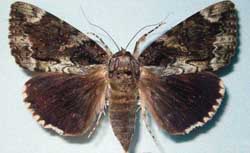
| ** 8794
Catocala lacrymosa;
Tearful Underwing, 60-82mm.
Form paulina: lighter grey post median area & area along and parallel to inner margin, in sharp contrast to
darker basal median areas.
|
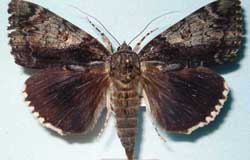
| ** 8794
Catocala lacrymosa;
Tearful Underwing, 60-82mm.
In form evelina there is a wide black band along the forewing inner margin.
|
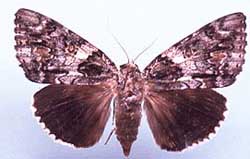
| ** 8794
Catocala lacrymosa;
Tearful Underwing, 60-82mm;; GSMNP/TP/WAM/KC.
In form albomarginata there is an abundance of white scaling on the forewing.
|
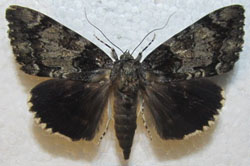
| ** 8794
Catocala lacrymosa;
Tearful Underwing, 60-82mm;; TP.
Form "zelica", has black basal patch and strong black subterminal line.
|
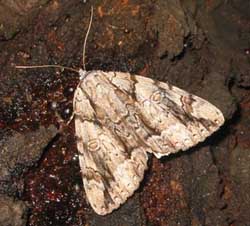
| ** 8792
Catocala vidua;
Widow; 70-80mm.
Fw ground colour light grey.
Distinguishing dark arc runs through top of reniform spot
to just below apex. Heavy, dark anal and basal
dashes, connecting to dark median bar, running parallel to i. m.
Am line thick, black in its upper half.
Reniform spot with two almost
concentric irregular ovals.
Subreniform spot light, open, constricted as it
meets pm line.
Hw black with broad, white fringe, lightly
interrupted.
Marie Winn image. |
Large Black Underwings (Banded): Wingspans: 70-80mm
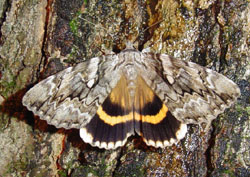
| ** 8802
Catocala cerogama;
Yellow-Banded; 70-80mm.
Several different forms. Pm line distinct, dark
and has elongate pair of projections. Pm and am lines meet inner
margin in relative proximity. Closed subreniform spot
lighter than surrounding areas, shaped a bit like an
arrowhead with point toward body. Hws are
distinctive. Jean-Benoît Duval image. |
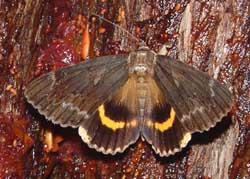
|
Form ruperti: Forewings are almost uniform grey-brown with white scales outlining subterminal line.
The hindwings are
distinctive. Tim Dyson image. |
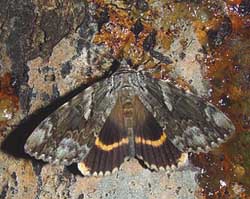
|
Form bunkeri: Forewings are dark in median and basal areas.
Hw golden band is reduced in thickness. Basal hairs are brown instead of yellow.
The hindwings are
distinctive. Tim Dyson image. |
Large Orange-Salmon Underwings: Wingspans: 65mm, usually 70-95mm
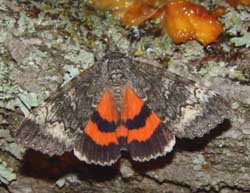
| #8817
briseis;
Briseis Underwing;
60-70mm;
Fws predominantly mottled dark-grey-brown with some lighter areas 1) between postmedial & subterminal lines, 2) at base of am & pm
lines along inner margin, 3) over subreniform spot running diagonally toward costa.
Pm lines do not have greatly elongated and sharly pointed "teeth" near apex.
Hw fringe white & unbroken, inner black band (fairly even) reaches inner margin.
Tim Dyson image.
|
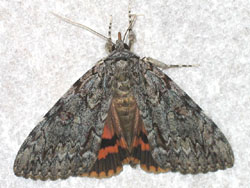
| #8795 Catocala palaeogama
; wingspan: 60-70mm.
Subreniform spot closed, does not approach pm line,
is smaller than in C. habilis.
All forms have characteristic orange, heavily barred fringe to
apex, and irregular bands on hws. Hw basal median
area heavily suffused with dark brown to black scales.
Dark bar in outer half of median area,
paralleling i. m. halfway between
i. m. and light, closed subreniform spot.
Joe Garris photo.
|
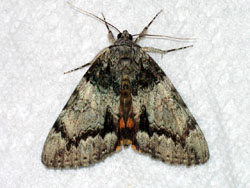
| #8795 Catocala palaeogama
form phalanga; wingspan: 60-70mm.
In this form, fw basal area and subterminal
area are very dark against a much lighter background.
Dark bar in the outer half of the
median area, paralleling the inner margin halfway between
the inner margin and the light, closed subreniform spot is especially
evident. Joe Garris image.
|
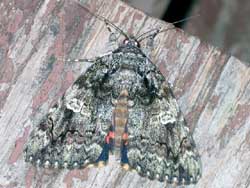
| ** 8801
Catocala ilia; Ilia;
wingspan: 65-82mm.
Several different forms,
most have characteristic white area in and around
reniform spot. Diffuse dark arc running from this
spot to just below apex. Subreniform spot squarish, concave inner and outer edges
and elongated constriction connecting it to pml.
White dots near fw om in character
with the overall "contrasting" appearance.
|
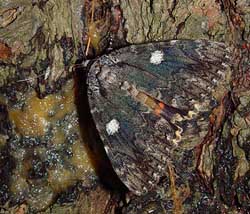
| ** 8801
Catocala ilia; Ilia;
form conspicua
In this form the entire reniform spot is heavily suffused with white scaling on
an otherwise darker ground colour. Hence the form name "conspicua".
Tim Dyson image.
|
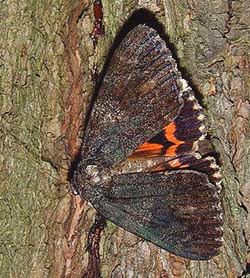
| ** 8801
Catocala ilia; Ilia;
form satanas
In this melanic form the entire forewing, including the reniform spot is very dark. Hence the form name "satanas".
The dark basal streak is still evident on this form.
Tim Dyson image.
|
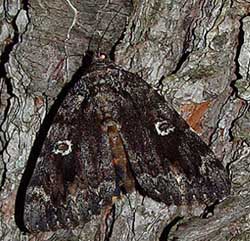
| ** 8801
Catocala ilia; Ilia;
form normani
In this semi-melanic form the entire forewing, excluding the reniform spot, is relatively dark.
The brownish, kidney-shaped center of the reniform spot is outlined in white.
The basal streak and subapical arc are still visible.
Tim Dyson image.
|
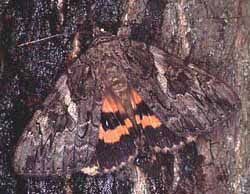
| ** 8771 Catocala piatrix ;
Penitent, wingspan: 68-84mm.
Fw: light-colored band/bar extending from light coloured, triangular
subreniform spot along am line to costa. Brown, kidney-shaped reniform spot surrounded in pale grey, outlined in black,
usually with distinct black along wing veins in a dark area outside the reniform spot.
Hw: fringe lightly barred; lighter in color
than deeper orange on rest of wing.
|
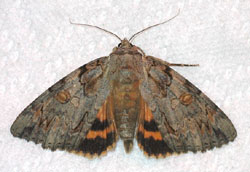
| ** 8798 Catocala neogama;
wingspan 70-85mm.
Brown head, thorax, larger size as compared to
C. palaeogama. Neogama tend to be slightly smaller
than subnata, have darker grey brown fws with more
pronounced markings. Examination of hind tibia needed
for id. Neogama's: flattened,
unevenly, sparsely spined; subnata's: cylindrical,
spines dense, uniform in distribution.
Joe Garris photo.
|
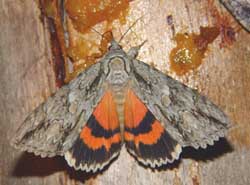
| ** 8806 Catocala parta;
Mother Underwing, wingspan: 70-85mm.
The black dashes in the basal, subapical and anal areas help to
identify this species. The hindwings may be yellow to
yellowish-orange but more often are salmon-red. Note the
face-head-like markings on the thorax.
In the hindwing, the first (nearest the apex) black protrusion into
the white fringe is "noticeably" larger than the others.
|
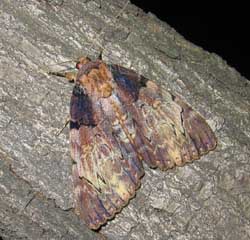
| Catocala nebulosa;
Moths have prominent dark brown upper-half-basal patch that extends
to and ends at antemedial line. Apical area also tends to be
brown, much darker than median area but not as dark as basal patch.
The anal angle also has the darker brown scaling.
The pm line is distinct near costa and inner margin, but becomes
weak between the two. It meets inner margin in relative close
proximity to am line.
Closed subreniform spot is large and connects to the
pm line via a thin line.
|
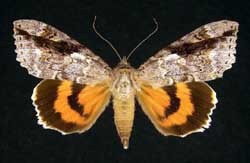
|
** 8804 C. marmorata;
Marbled; wingspan 85-95mm
Dark fw arc runs from costa down through reniform spot to outer margin just below apex.
The subrenifrom spot is light, is bordered inwardly above by a white patch, and is
connected to the pm line by a line rather than being open.
|
Medium-Large Pink Underwings: Wingspans: 70-95mm
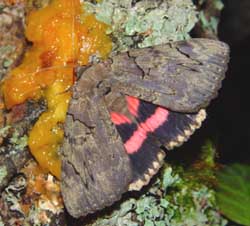
| ** 8832 Catocala cara;
Darling; 70-85mm.
Note deep maroon almost purple cast to fws, mixed with
very pale green. Lower half of am & pm lines is barely
visible. There are no distinctive bars or dashes. The two upper
"teeth" on the pm line are thin and long.
The hindwing bands are pink. There is heavy black checking on the
off-white hindwing fringe. The relatively thick black median band of the
hindwing almost reaches the inner margin which is usually heavily
adorned with dark hairs.
Tim Dyson image.
|
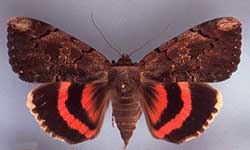
| ** Catocala carissima;
wingspan 70-85mm. Distinct light grey brown area at fw apex, preceded just inside pm line by slightly darker patch.
Am and pm lines sharp and dark.
Hw inner black band wide, complete, merges with extensive grey-black scaling along im. Hw fringe cream coloured.
|
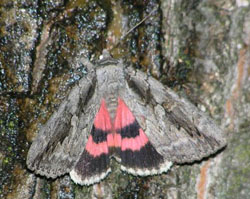
|
** 8834 amatrix
Sweetheart Underwing; (wingspan 75-95mm).
Very skittish, frequently hides in caves, under
bridges, under tree bark, etc. by day, resting with head down.
Hw patterning and colouration similar to that of
C. concumbens, but large size (wingspan 75-95mm)
and dark bar running from basal area to just below apex
distinguishes C. amatrix. See large
Catocala amatrix courtesy of
Joan F. Rickert.
|
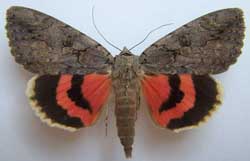
|
** 8834 amatrix form selecta
Sweetheart Underwing; (wingspan 75-95mm)
Very skittish and frequently hides in caves, under
bridges, under tree bark, etc. by day, resting with head down.
Several forms, including selecta (to the left)
which lacks dark bar on forewing. Hesseli: melanic form;
pallida: very pale form.
|
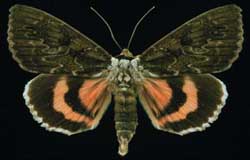
|
** 8834 amatrix form hesseli
Sweetheart Underwing; (wingspan 75-95mm)
Very skittish and frequently hides in caves, under
bridges, under tree bark, etc. by day, resting with head down.
The melanic form hesseli is very dark and displays dark basal hairs in the hindwing.
|
|















































